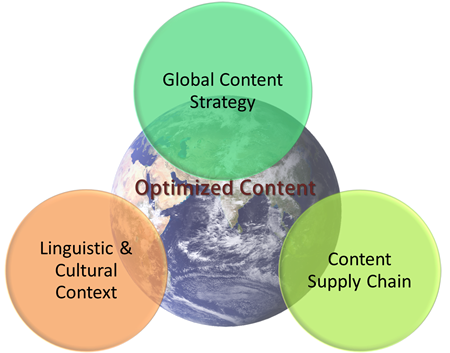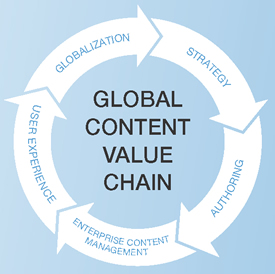Editor’s note: TechWhirl recently sat down with three experts in the fast-evolving industry of content translation and localization: Val Swisher, Founder and CEO of Content Rules; Diana Ballard, Business Development Manager for Logos Group; and Steve Walker, Senior Director of Global Content Solutions at Experis, to gain perspective and get guidance on preparing content for global audiences. Part 1, which follows, starts with the fundamentals of concepts, strategy, and supply chain. In part 2, these experts share tips and best practices for content teams embarking on content optimization.

Preparing content for a global audience requires content cultural strategy, context, and a global content supply chain
Think Global: Concepts, Strategies and the Global Content Supply Chain
Growth. While the U.S. still leads the world in the size and strength of its economy, it’s a maturing market that’s tough to get into and tougher still to grow and dominate. Global Growth Generator (3G) countries lure businesses from the U.S. and other top economies with the promise of new customers and bigger margins. As more and more companies enter the global marketplace, they face substantial shifts in every aspect of how they operate. Departments and teams responsible for preparing content for numerous internal and external audiences can no longer rely on English being “the language of business.” Content must be globalized, translated, localized and often transcreated to satisfy consumers who want to search, learn and buy in their own language in the comfort of their own culture. So content professionals must be ready to plan, create and deliver content that appeals to a global audience… or rather many audiences that make up the global marketplace.
Gone are the days when non-U.S. markets would purchase a product or service just because it “was made in the USA.” A study published by Common Sense Advisory found that more than half of consumers (52.4%) prefer to make internet purchases in their own languages. And a whopping 80% look for pre-purchase information in the own languages before they buy. These figures suggest that for companies to truly compete in local markets they must make content localization a business imperative. But while the situation is changing, most companies prepare and deliver content geared only to English speakers and rarely do they optimize content for even their English-speaking customers.
From the Beginning: Defining the Concepts of Globalization
Getting the right expertise to help in planning and preparing content for global audiences should start with understanding the terminology—after all, you can’t leverage expertise if you don’t know what expertise to seek.
According to Val Swisher, Founder of Content Rules and board member for Translators Without Borders, optimizing content for global markets “means paying attention to your words, pictures, layout, design, media, and so on, to make sure that you’re getting at the essential information without cultural bias.” Optimization encompasses both translation, which she defines as “when you take content, word-for word from one language to another,” and localization, “when you adapt content to make it more meaningful, appropriate, and effective for a particular culture, locale, or market.”
A relatively new term, transcreation, is coming into its own as more organizations struggle with getting the right content to their global audiences. Diana Ballard, Senior Business Development Manager with Logos Group, says transcreation occurs when “the translator is invited to adapt in text to their target language to capture emotion and nuance. It’s a freer translation, but it will engage the user in a similar manner as users speaking the source language.”
The Fundamentals: Global Content Supply Chain and Global Content Strategy
GALA, the Globalization and Localization Association, reports that over 7,000 languages are spoken throughout the world. It notes that 83 languages would reach over 80% of the world’s population. At first glance, that still represents an unfathomable amount content to prepare for consumption in local markets. Where should content teams start?

The global content supply chain, or value chain, drives the organization’s processes in preparing and delivering content
Steve Walker, Senior Director of Global Content Solutions at Experis, firmly believes that successful global content creation begins with understanding of the global content supply chain. “To get a good handle on the global content supply chain, content producers need to 1) identify clear personas upfront—both global profiles and functional profiles; 2) gain visibility into targeted regions and languages; and 3) develop an understanding of the globalization process as whole. According to Steve, a comprehensive view of a client’s content supply chain is the first step toward optimizing the process. “There are things to do in content creation that ease distribution, reduce translation costs that standardize processes and gain efficiencies throughout.”
Val sees a need, and an opportunity, for content strategists’ involvement before planning begins on global content optimization. “There’s not enough attention paid to having a global content strategy. It’s amazing how many people I talk to who are taking content into 18 languages who don’t think they need it. Companies need to think about this all the way from the beginning to the end.” She says it’s easy to see when a company hasn’t thought through their content strategy, such as a recent foray on a French retail site, where she discovered that content had been translated to only three levels. “You couldn’t search in French past that point. Considering the size of the company, it was pretty shocking.”
Diana agrees, explaining that companies should ensure that a global content strategy aligns with their business objectives. “These companies need to be asking ‘What’s the value of the export market? What are the objectives to reach it? And how will our content support it?’”
Like Steve, Diana says that content teams need acquire extensive cultural and language insight to have the context necessary for translation and transcreation work. “For example, the superlatives marketing often applies to products in American markets don’t work well in other contexts such as Germany, where consumers look for unbiased straightforward information.”
Context Always Drives Global Content Optimization
Because context is critical in successfully navigating new markets, Diana advocates for making translators integral members of the content team. “Translators normally only have the words, they don’t have the benefit of context,” and without it, translation suffers. “Consider the translator as part of your team,” she says, “and step back and think about if the context wasn’t available would it be understandable to someone in another culture or country.”
To Steve, context is about content relevance. He goes back to the definition of content optimization and notes “as you start peeling it back, to me it’s about making your content relevant—whether it’s cultural, languistic, or geographic content—relevance should be the key driving force for all content producers.”
Optimizing Content for Global Audiences Produces Better Source Content
If the reader cannot comprehend the content they’re consuming, the content fails to achieve its goals. In fact, the National Center for Education Statistics reports that only 13 percent of adults are “proficient” in English. “Take the content and approach it from the level of 12 year old,” Val says. “What you end up with is very clear, very concise, very simple English content. It does not mean that anyone will think less of your company because it’s simple.” Clear and concise content translates much more easily into target languages.
Clients of Content Rules get the benefit of her focus on optimizing content from the start, and she offers a set of starting guidelines to revamp the content creation process:
- Pay attention to grammar and sentence structure—do not write like you speak. If you do, you’re leaving it up to the translator to make judgments.
- Make sure you say the same thing the same way every time you say it. If you say it 72 different ways it’s translated 72 times for each language. Avoid adding synonyms to the content just for the sake of using them.
- Use as few words as possible to describe something. Practice minimalism.
- Avoid jargon and colloquial expressions, they rarely translate well.
- Keep sentences as short as possible−no more than 26 words.
- Make images neutral. Geopolitics is always changing, so using images such as flags is risky.
Val points to her work with Translators Without Borders as a prime example of the universal improvements to content when it’s optimized for global audiences. The group is working on WikiProject: Medicine, an effort to simplify and translate the top 100 most frequently accessed medical articles in Wikipedia. “What we discovered, and people in Wikipedia community finally understand, is that a reader goes to Wikipedia, very worried about a symptom, and they cannot begin to understand the content of the article that comes up on their search.
In fact, she says despite a graduate degree, she sometimes has difficulty understanding the content. “Now that we’ve simplified the articles, I can read them, the average American can read them, and translators can successfully translate them. English simplifications make a huge difference to communities, especially with obvious areas like medical information. But the same kind of results happen in the corporate arena with simplified content for customers and prospects.”
Summary
True success in global markets depends on much more than relying on shareware translation algorithms. All three of these experts agree that companies who want to enter new markets must approach the entire content lifecycle—from creation and optimization to distribution, retirement, archiving, and destruction—as a major initiative, requiring budget, resources and extensive preparation.
The organization mindset comes first. Steve says, “Companies need to be changing the orientation, where a content producer is no longer just creating a help manual. Instead, he or she is supporting part of the customer experience process. They are helping a customer obtain the information to do something important to them.”
Val advises that any company planning to go global should start their preparations with one simple, but essential step. “Stop thinking that everyone sees the world like you see it. It’s a mindset change to think more globally, and it is absolutely essential for companies that do business around the world.”
 |
 |
 |
| As senior business development manager at Logos Group, Diana Ballard has 20 years’ experience in the localization industry. Having previously served as technical publications manager in a fast-paced Japanese manufacturing environment over 6 years, she appreciates the demands of localization from both client and vendor perspectives. Graduating from the University of Liverpool with Joint Honours in languages (English major), Diana spent her early career years in management consulting gaining a vital appreciation of how businesses manage improvements across the enterprise. | Steve Walker, a senior director in the Experis Global Content Solutions practice, draws upon his 20 years’ experience in guiding clients to strategically create, manage, and deliver information worldwide. Technology agnostic, he brings a breadth of knowledge in content and resource management to solving complex business challenges. As a thought leader in the enterprise content management space, Steve has hands-on experience in business strategy, digital marketing, software development, content authoring, content management system implementation, and business and IT consulting. Steve provides a unique business perspective to educating clients on trends in all aspects of the content lifecycle. | Val Swisher is the CEO of Content Rules. She is a well-known expert in global content strategy, content development, and terminology management. Using her 20 years of experience, Val helps companies solve complex content problems by analyzing their content and how it is created.When not helping customers, Val can be found sitting behind her sewing machine working on her latest quilt. She also makes a mean hummus.
|
Resources
- Can’t Read, Won’t Buy: Why Language Matters on Global Websites, Common Sense Advisory, Donald A. DePalma, Benjamin B. Sargent, and Renato S. Beninatto, September 2006(Updated February, 2014), downloaded May 6, 2014.
- Global Growth Generators: Moving beyond ‘Emerging Markets’ and ‘BRIC.’ Willem Buiter and Ebrahim Rahbari, Citi Investment Research & Analysis, March 2011, downloaded May11, 2014.
- National Assessment of Adult Literacy, US Department of Education, National Center for Education Statistics, downloaded May 12, 2014.
- Why Localize? Globalization and Localization Association (GALA), downloaded May 11, 2014.
- WikiProject Medicine, accessed May 12, 2014.